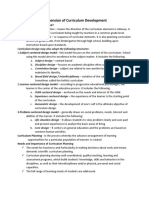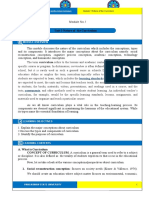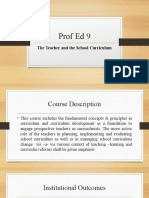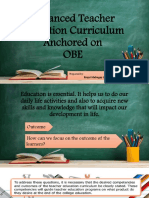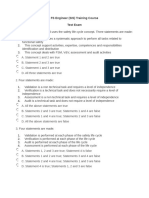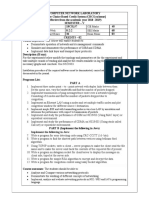Lesson 3: The Role of Technology in Delivering The Curriculum
Uploaded by
Edlord MosterLesson 3: The Role of Technology in Delivering The Curriculum
Uploaded by
Edlord MosterModule 4: The Teacher as Curriculum Implementor and Manager
Lesson 3: The Role of Technology in Delivering the Curriculum
Intended Learning Outcomes:
Discuss roles of technology in curriculum delivery
Enhance the application of outcomes-based learning with technology both as an
aid and platform for learning
Analyze the significance of systematic lesson planning in which the appropriate
choice of media comes to play
Take Off
After learning fundamental concepts about the curriculum-its nature and
development, comes the practical phase of curriculum implementation. Appropriately, the
significance of technology in curriculum development deserves discussion.
The role of technology in the curriculum springs from the very vision of the e-
Philippine plan. Thus it is stated: “an electronically enabled society where all citizens live in
an environment that provides quality education, efficient government services, greater
sources of livelihood and ultimately a better way of life through enhanced access to
appropriate technologies”. This points to the need for an e-curriculum, or a curriculum which
delivers learning consonant with the Information Technology and Communications
Technology revolution. This framework presupposes that curriculum delivery adopts ICT as
important tool in education while users implement teaching-learning strategies that conform
to the digital environment. Following a prototype outcomes-based syllabus, this same
concept is brought about through a vision for teachers to be providers of relevant, dynamic
and excellent education programs in a post-industrial and technological Philippine society.
Thus among educational goals desired for achievement is the honing of competencies and
skills of a new breed of students, now better referred to as a generation competent in
literacies to the 3 Rs (reading, ‘riting and rithmetic) but influences, more particularly:
problem-solving fluency, information access and retrieval of texts/images/sound/video
fluency, social networking fluency, medical fluency, and digital creativity fluency.
Content Focus
Instructional media may also be referred to as media technology or learning
technology.
Technology plays a crucial role in delivering instruction to learners. Technology offers
various tools of learning and these range from non-projected media from which the teacher
can choose, depending on what he sees fit with the intended instructional setting. For
example, will a chalkboard presentation be sufficient in illustrating a mathematical
procedure; will a video clip be needed for motivating learners?
In the process, what ensues is objective-matching where the teacher decides on
what media or technology to use to help achieve the set learning objectives.
Non-Projected media Projected media
Real objects Overhead transparencies
Models Opaque projection
Field trips Slides
Kits Filmstrips
Printed materials Films
Visuals Video, VCD, DVD
Visual boards Computer/multimedia presentation
Audio materials
Table 1. Types of instructional media/technology
Factors in Technology Selection
In deciding on which technology to use from a wide range of media available, the factors
on which to base selection are:
1. Practicality. Is the equipment or already prepared lesson material available? If
not, what would be the cost in acquiring the equipment or producing the lesson in audial or
visual form?
2. Appropriateness in relation to the learners. Is the medium suitab;e to the
learners’ ability to comprehend? Will the medium be a sources of plan amusement of
entertainment, but not learning?
3. Activity/suitability. Will the chosen media fit the set instructional event, resulting
in either information, motivation or psychomotor display?
4. Objective-matching. Overall, does the medium help in achieving the learning
objectives?
The Role of Technology in Curriculum Delivery
It can easily be observed that technological innovation in the multifarious fields of
commerce, science and education, is fast developing such that it is difficult to foresee the
technological revolution in the millennium, inclusive of education changes. For certain
however, technological changes in education will make its impact on the delivery of more
effective. Efficient and humanizing teaching-and-learning.
But presently, we can identify three current trends that could carry on the nature of
education in the future. The first trend is the paradigm shift from teacher-centered to
students-centered approach to learning. The second is the broadening realization that
education is not simply a delivery of facts and information, but an educative process of
cultivating the cognitive, affective, psychomotor and much more the contemplative
intelligence of the learners of a new age. But the third and possibly the more explosive trend
is the increase in the use of new information and communication technology or ICT.
Already at the turn of the past century, ICT, in its various forms and manifestations
has made its increasing influence on education, and the trend is expected to speed up even
more rapidly. Propelling this brisk development is the spread of the use of the computer and
availability of desktop microcomputers affordable not only to cottage industries, businesses
and homes but also to schools.
For now the primary roles of educational technology in delivering the school
curriculum’s instruction program have been identified.
Upgrading the quality of teaching-and-learning in schools
Increasing the capability of the teacher to effectively inculcate learning, and for
students to gain mastery of lessons and courses.
Broadening the delivery of education outside schools through non-traditional
approaches to formal and informal learning, such as Open Universities and lifelong
learning to adult learners.
Revolutionizing the use of technology to boost educational paradigm shifts that give
importance to students-centered and holistic learning.
Self Check
Make a visual material or presentation (Power Point Slides Presentation) of
your chosen specific subject area, the module which you have made in your previous lesson
will be utilized here. Select a partner and evaluate your outputs.
Using the following criteria below answer YES if it complies with the criteria and NO if it does
not comply with the criteria.
Visual elements (pictures, illustrations, graphics):
1. Lettering style or font – consistency and harmony
2. Number of lettering style- no more than 2 in a static display (chart, bulletin board)
3. Use of capitals – short title or headlines should be no more than 6 words
4. Lettering colors-easy to see and read. Use of contrast is good for emphasis
5. Lettering size – good visibility even for students at the back of the classroom
6. Spacing between letters-equal and even spacing
7. Spacing between lines – not to close as to blur at a distance
8. Number of lines – no more than 8 lines of text in each slide
9. Appeal – unusual, two-dimensional, interactive (use of overlays)
10. Use of directional – devices (arrows, bold letters, bullets, contrasting colors and
size placement of an item)
Overall look: patterns of alignment, shape, balance, style, color scheme and color
appeal
Give your overall impression about the PPT presentation of your partner.
Educators are now more keenly aware of their responsibility to deliver the highest
quality of education to learners. They also recognize the need to use and integrate
technology in the curriculum and the teaching-learning process of classroom instruction.
There is no doubt, however that the concept of education technology is a very complex one,
made more sophisticated with the advent of what is called hypermedia or multimedia
packages that include: text, audio, graphic image, animation and video clip.
Today, hypermedia find an application in what is known as Information and
Communication Technology or ICT that includes tutorial software packages, webpages,
simulation games, project management packages and others. An example is the hypermedia
package in Economics which can be accessed through the Internet site WinEcon.
Everyday technology including Information and Communication Technology,
advances by leaps and bound, thus as it advances we can be certain that educational
technology will continue to play an important role in education. In the traditional approach to
instruction, the teacher a. presents the lesson to the class, b. assesses the students and c.
moves to the next lesson.
Self Reflect
In a proposed mastery approach to instruction, the teacher a. presents the lesson to
the whole class, b. assesses if learners attained mastery of the lesson, c. provides
enrichment activities with the of media technology, d. re-mediates the non-mastery student,
e. moves on the next lesson.
1. How is the mastery approach better than the traditional one?
2. The mastery approach appears time-consuming and difficult. Do you believe practice and
experience can overcome these difficulties?
3. How can technology help in enrichment activities?
4. Should the effective use of media be also assessed by the teacher? Why?
You might also like
- Report - Curriculum Design and Organization100% (6)Report - Curriculum Design and Organization43 pages
- Curriculum Development Reforms and Enhancement95% (40)Curriculum Development Reforms and Enhancement51 pages
- Final Module Teaching Technology in The Elementary Grades100% (1)Final Module Teaching Technology in The Elementary Grades18 pages
- Lesson 1: What, Why and How To Evaluate A Curriculum: Module 5: Evaluating The Curriculum Module Overview80% (5)Lesson 1: What, Why and How To Evaluate A Curriculum: Module 5: Evaluating The Curriculum Module Overview7 pages
- EDUC 323C UNIT 1 LESSONS A and B Definition Major Conceptions of CurriculumNo ratings yetEDUC 323C UNIT 1 LESSONS A and B Definition Major Conceptions of Curriculum23 pages
- The Role of Technology in Delivering The Curriculum100% (10)The Role of Technology in Delivering The Curriculum36 pages
- Implementing The Designed Curriculum As A Change Process67% (3)Implementing The Designed Curriculum As A Change Process4 pages
- National Competency Based Standards For School Heads (NCBS-SH)100% (1)National Competency Based Standards For School Heads (NCBS-SH)109 pages
- Methodological Dimension of Curriculum Development100% (2)Methodological Dimension of Curriculum Development2 pages
- Unit 1 Maintenance Management and Terotechnology: An OverviewNo ratings yetUnit 1 Maintenance Management and Terotechnology: An Overview9 pages
- CS553 Homework #4: Understanding The Cost of Cloud ComputingNo ratings yetCS553 Homework #4: Understanding The Cost of Cloud Computing3 pages
- The Role of Technology in Delivering The Curriculum100% (2)The Role of Technology in Delivering The Curriculum2 pages
- The Role of Technology in Delivering The CurriculumNo ratings yetThe Role of Technology in Delivering The Curriculum22 pages
- Implementing A Curriculum Daily in The Classrooms: Lesson 4.2100% (1)Implementing A Curriculum Daily in The Classrooms: Lesson 4.29 pages
- Chapter 9 - The School Head in School-Based Management100% (3)Chapter 9 - The School Head in School-Based Management2 pages
- Analyzing The Salient Parts of The Learning Plan: Name: Jovanne F. Clapano Course & Section: BSED English 3A100% (1)Analyzing The Salient Parts of The Learning Plan: Name: Jovanne F. Clapano Course & Section: BSED English 3A2 pages
- The Teacher and The Curriculum Module 1.2.docx-1100% (1)The Teacher and The Curriculum Module 1.2.docx-14 pages
- Select and Use ICT Tools For Teaching and Learning 4A Lesson PlanNo ratings yetSelect and Use ICT Tools For Teaching and Learning 4A Lesson Plan3 pages
- Module 1 The Teacher and The School Curriculum0% (1)Module 1 The Teacher and The School Curriculum8 pages
- Final Term Lecture 1 8M's, Dale, BrunnerNo ratings yetFinal Term Lecture 1 8M's, Dale, Brunner34 pages
- The Teacher & The Community, School Culture & Organization: Group 14100% (1)The Teacher & The Community, School Culture & Organization: Group 1454 pages
- Implementing Curriculum As A Change ProcessNo ratings yetImplementing Curriculum As A Change Process2 pages
- Module 2 The Teacher and The School Curriculum100% (3)Module 2 The Teacher and The School Curriculum14 pages
- Module-2-The-Teacher-as-a-knower-of-curriculum FNo ratings yetModule-2-The-Teacher-as-a-knower-of-curriculum F20 pages
- Prof Ed 9: The Teacher and The School Curriculum67% (3)Prof Ed 9: The Teacher and The School Curriculum11 pages
- Module 3 Principles of High Quality Assessment100% (1)Module 3 Principles of High Quality Assessment7 pages
- Curriculum Evaluation Through Learning Assessment100% (1)Curriculum Evaluation Through Learning Assessment22 pages
- Chapter II The Teacher in The Classroom and CommunityNo ratings yetChapter II The Teacher in The Classroom and Community36 pages
- Enhanced Teacher Education Curriculum Anchored On100% (11)Enhanced Teacher Education Curriculum Anchored On41 pages
- Module 4 - The Teacher As Curriculum Designer100% (2)Module 4 - The Teacher As Curriculum Designer14 pages
- SED 3205 - Unit 1 - Definition of Traditional Literacies100% (2)SED 3205 - Unit 1 - Definition of Traditional Literacies20 pages
- Chapter 3 Curriculum Planning Module (FINAL)100% (5)Chapter 3 Curriculum Planning Module (FINAL)26 pages
- Module 4 Building and Enhancing Literacies Across The Curriculum BADARANNo ratings yetModule 4 Building and Enhancing Literacies Across The Curriculum BADARAN15 pages
- The Survey On The Use of ICT in The Teaching and Learning For Teachers100% (2)The Survey On The Use of ICT in The Teaching and Learning For Teachers5 pages
- Lesson 2: Implementing The Curriculum Daily in The Classroom50% (2)Lesson 2: Implementing The Curriculum Daily in The Classroom9 pages
- Lesson 4: Stakeholders in Curriculum Implementation: Module 4: The Teacher As Curriculum Implementor and Manager100% (2)Lesson 4: Stakeholders in Curriculum Implementation: Module 4: The Teacher As Curriculum Implementor and Manager5 pages
- Smart Grid Challenges and OpportunitiesNo ratings yetSmart Grid Challenges and Opportunities18 pages
- CewePrometer Product Presentation A0151e-10No ratings yetCewePrometer Product Presentation A0151e-1012 pages
- Honda Motorcycle 1987 OEM Parts Diagram For Right Crankcase Cover - Partzilla - Com - CopieNo ratings yetHonda Motorcycle 1987 OEM Parts Diagram For Right Crankcase Cover - Partzilla - Com - Copie7 pages
- How To Configure Network Load BalancingNo ratings yetHow To Configure Network Load Balancing13 pages
- Technological Forecasting & Social ChangeNo ratings yetTechnological Forecasting & Social Change13 pages
- LESSON#9 SURGE PREVENTION IN THE CENTRIFUGAL COMPRESSOR - Jeff Lee100% (1)LESSON#9 SURGE PREVENTION IN THE CENTRIFUGAL COMPRESSOR - Jeff Lee42 pages
- Eaglemaster CL 5000A - Operation InstructionNo ratings yetEaglemaster CL 5000A - Operation Instruction4 pages













